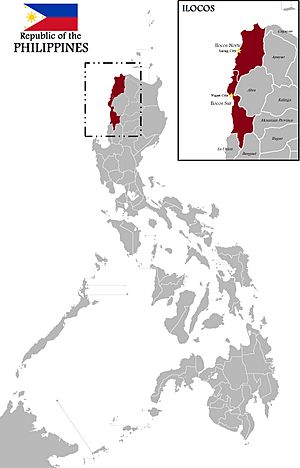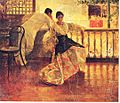Ilocos facts for kids
Ilocos refers to two important provinces in the Philippines: Ilocos Norte and Ilocos Sur. People who live here are called Ilocanos. They speak a language known as Ilocano.
The larger area around these provinces is called the Ilocos Region. It's good to know that not everyone in this region is Ilocano. For example, about 28% of the people are Pangasinan, who have their own language and culture.
Contents
What is the Ilocos Region?
The Ilocos Region is officially known as Region I. It is located on the northwestern part of Luzon, which is the largest island in the Philippines. This region is known for its beautiful coastlines, old towns, and rich history.
Provinces of Ilocos
The Ilocos Region includes four provinces. Two of them are Ilocos Norte and Ilocos Sur. The other two are La Union and Pangasinan. Each province has its own unique features and attractions.
Ilocos Norte: The North Star
Ilocos Norte is the northernmost province. Its capital city is Laoag City. This province is famous for its sand dunes, historic churches, and windmills that generate electricity. It's a great place to visit for adventure and history.
Ilocos Sur: A Glimpse into the Past
Ilocos Sur is known for its well-preserved Spanish colonial town, Vigan City. Vigan is a UNESCO World Heritage Site. Walking through its cobblestone streets feels like stepping back in time. The capital of Ilocos Sur is also Vigan City.
La Union: Surfing Capital
La Union is often called the "Surfing Capital of Northern Luzon." Its capital is San Fernando, La Union. Many people visit La Union for its beaches and waves, perfect for surfing. It also has beautiful waterfalls and natural parks.
Pangasinan: Land of Salt
Pangasinan is the southernmost province in the region. Its capital is Lingayen. The name "Pangasinan" means "land of salt" or "place of salt-making." This province is famous for its delicious seafood and the "Hundred Islands National Park."
Culture and People
The Ilocano people are known for being hardworking and resourceful. They have a strong sense of community and family. Their culture is rich with traditions, folk songs, and dances.
Ilocano Language
The Ilocano language is the third most spoken native language in the Philippines. It is used by millions of people in the Ilocos Region and other parts of Luzon. It has a unique sound and many interesting words.
Traditional Ilocano Food
Ilocano cuisine is very popular in the Philippines. Some famous dishes include pinakbet, which is a vegetable stew. Another one is dinakdakan, made from pork. These foods often use local ingredients and unique flavors.
Economy and Livelihood
The economy of the Ilocos Region relies on several activities. Farming is a major source of income. Fishing is also important, especially along the coastlines.
Agriculture in Ilocos
Farmers in Ilocos grow various crops. Rice and corn are the main products. They also grow tobacco, garlic, and onions. The fertile lands help these crops grow well.
Tourism in Ilocos
Tourism is a growing industry in the Ilocos Region. Many local and international tourists visit the historical sites, beaches, and natural wonders. This helps create jobs and supports the local economy.
History of Ilocos
The Ilocos Region has a long and interesting history. Before the Spanish arrived, the area had thriving communities. The Spanish colonial period greatly influenced the region's culture and architecture.
Spanish Influence
The Spanish came to Ilocos in the 16th century. They built churches, towns, and introduced new ways of life. Many old churches and buildings from this time can still be seen today, especially in Vigan.
Modern Ilocos
Today, the Ilocos Region continues to develop. It balances its rich history with modern progress. The people work together to preserve their heritage while building a better future.
Images for kids
See also
 In Spanish: Ilocos para niños
In Spanish: Ilocos para niños




